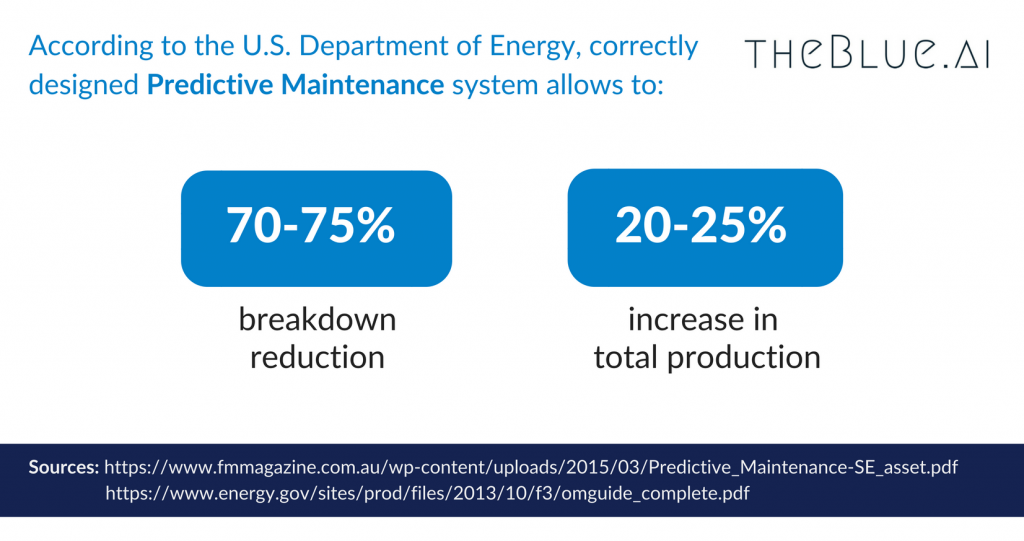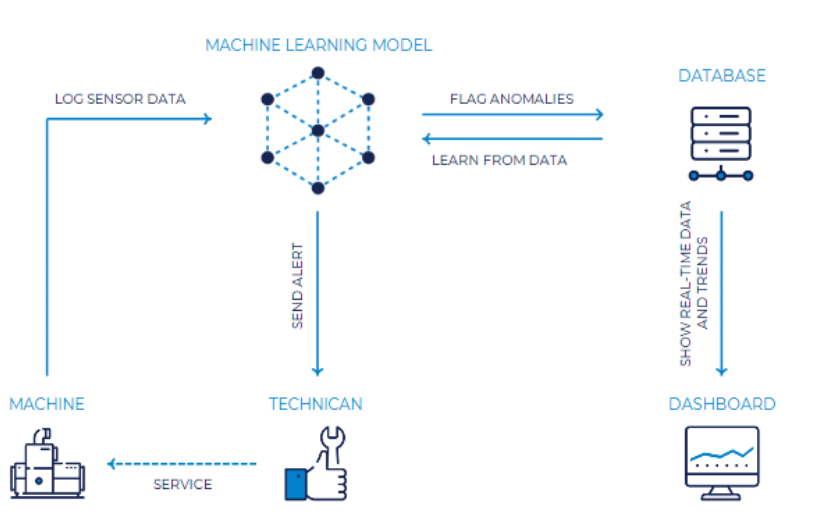Predictive Maintenance - practical use in companies
From fear, confusion, and anxiety to fascination and excitement. Artificial Intelligence raises many emotions.
One of the major operating costs of production plants is spendings directly or indirectly related to the maintenance of a company’s assets. How much manufacturers spend on keeping their machines in the right conditions is the rather individual case as every production line and its environment differs.
Although, as many field studies show, maintenance costs can represent even up to 60% of the expenses of produced goods. This high value usually refers to heavy industries, while in light industries maintenance can be lower and fall to the level of about 15-20%. Still, manufacturers have to handle these costs and keep in mind that they have a significant influence on a final product price.
Except for the spendings on maintaining its assets, companies must also take into account that service actions they perform highly influence whole production quality and quantity. One faulty element of a production line can affect all batch of produced items. This may lead to additional unplanned breakdowns, customer dissatisfaction and related with them random costs.
What is predictive maintenance?
Maintenance itself can be briefly described as numerous actions/activities that are taken to maintain a certain level of reliability of the production assets that aims to minimize the risk of unplanned failures and quality loss of manufacturing process. How maintenance is performed depends on the types of goods that are produced and how production is organized. Nonetheless, it is crucial for each manufacturer to develop the best possible maintenance system that utilizes possibilities of Big Data, IoT, and Artificial Intelligence. And this is why Predictive Maintenance was invented.
Predictive maintenance (PdM) is a condition driven proactive approach that uses innovative technologies to evaluate the risk of potential failures and to schedule actions to minimize the possibility of unplanned downtime. It provides companies with the opportunity to gain deep insight into real-time operations performed within the plant, evaluate the state of machines and reduce the cost of equipment ownership. Well designed maintenance program, without any human supervision, can accurately measure asset’s condition and proactively schedule next required service tasks so it will not affect production efficiency.
Except for PdM, there are also two other main maintenance approaches: Reactive Maintenance (also called Run-to-failure approach) and Preventive Maintenance (PM). The main difference between them and PdM is that they don’t use any of the latest Industry 4.0 innovations, and therefore, maintaining company’s assets using these techniques is associated with decision making based on a very restricted number of data which can be highly inaccurate. The table below presents a more detailed comparison of all three approaches.
| Run-to-failure | Preventive Maintenance | Predictive Maintenance | |
| Type of approach | Reactive | Proactive (time driven) | Proactive (condition driven) |
| What triggers the maintenance? | Machine’s failure | Time (elapsed hours of operation) | Detection of potential failure based on light differences in machine performance |
| Statistical/ Key metrics | – | Mean-time-to-failure (MTTF)
Mean-time-between-failures (MTBF) |
Real-time estimation of asset’s condition based on all available data |
| Major costs | Spare parts
inventory cost, overtime labor costs, high machine downtime, low production availability |
Frequent maintenance actions, wastes caused by repairing/servicing fully operational parts
|
Costs of developing machine learning powered system that tracks the current state of production components |
| Spare parts management | -Extensive spare parts inventories of all critical components
-Relying on immediate spare parts delivery by equipment vendors |
-Estimation of required supplies based on planned maintenance works
-Risk of missing spare parts in case of unplanned breakdowns |
-Automated spare parts management based on actual needs of production lines
-The possibility of integration with procurement system, so only required elements are stored on site. |
| Recommendation/ target group | Small production plants where:
– machine condition cannot affect final product quality – breakdowns are acceptable (does not require high availability of resources) |
Small and medium manufacturers who:
-can accept occasional production interruptions -cannot afford PdM implementation or investing in PdM would not give a substantial return |
Big production plants that require to:
– achieve the best possible product quality – minimize maintenance time (only when required) -produce their goods continuously -have best possible insight in data generated by a company
|

Predictive Maintenance workflow
The Predictive Maintenance workflow starts with data from sensors attached to production machines. The current state of the asset is sent to the Machine Learning model where real-time readings are validated. At this point algorithm learned on past data from IoT devices detects all anomalies, potential future failures and time left for next required service.
In any emergency situations model sends information directly to Technicians’ department, so immediate actions can be taken. All data processed by the ML model and the output of this processing are saved to a database, which is also a source for an algorithm for pretraining on new data. This way model adjusts to changing the environment and increase its ability to detect all relevant changes in the machine’s performance.
 Results of the analytical part of the workflow are presented on a dedicated dashboard. It gives additional analytical capabilities and provides better insights into how machines work.
Results of the analytical part of the workflow are presented on a dedicated dashboard. It gives additional analytical capabilities and provides better insights into how machines work.
Predictive techniques
As already mentioned, PdM handles multiple tasks related to maintaining the assets of a company. Though, different models need to be applied to get the best possible quality of estimations.
The most common ML techniques adopted in PdM are a regression, classification, anomaly detection and survival analysis. In realization of above methods following algorithms can be used to build and find an optimal model that suits company’s data best: Logistic regression, Multivariate classifiers, Decision Trees (e.g., Random Forest), Deep Learning models (Neural Networks).
Application of presented techniques can be made in several areas:
- Vibration analysis,
- Temperature analysis,
- Infrared thermography,
- Tribology and oil analysis,
- Pressure analysis,
- Ultrasound analysis.
Each of mentioned analyzes can be performed separately and give insight on how particular measures behave in time. Although, in many PdM applications best predictions are achieved when a combination of multiple different sensors of same production asset is used. This way ML model can catch some hidden patterns in data and therefore estimate machine’s state better that human could.
Benefits of using predictive maintenance
Implementation of predictive maintenance can provide a spectrum of competitive advantages for companies. When it comes to the maintenance itself, It improves machine uptime, lifetime extension of aging assets, a lower inventory of spare parts and a decrease of randomly occurring and unscheduled events. Moreover, it minimizes risks connected to the health and safety of employees and helps to boost the quality. The result of all of the above can be the significant impact on the cost reduction.
Are you curious how does business use AI? Read use cases on our blog!






